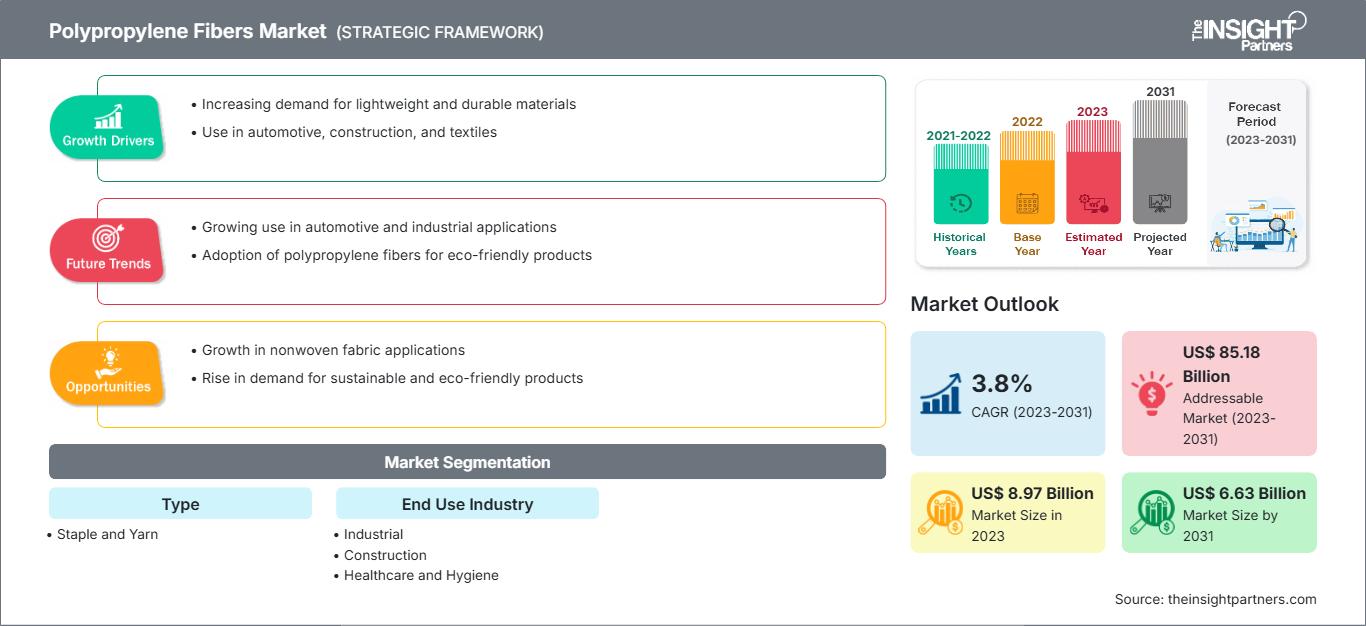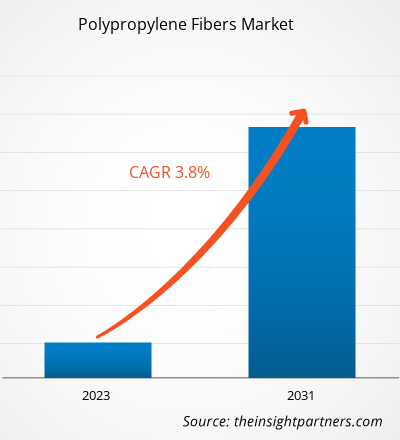Se proyecta que el tamaño del mercado de fibras de polipropileno alcance los 6.630 millones de dólares estadounidenses para 2031, frente a los 8.970 millones de dólares estadounidenses de 2023. Se espera que el mercado registre una tasa de crecimiento anual compuesta (TCAC) del 3,8 % entre 2023 y 2031. Es probable que la demanda de productos sanitarios e higiénicos siga siendo una de las tendencias clave del mercado de fibras de polipropileno.
Análisis del mercado de fibras de polipropileno
La creciente demanda de fibra de polipropileno en la industria de la construcción ha impulsado el crecimiento de su mercado. El hormigón es un material de construcción ampliamente utilizado debido a su uso en edificios sostenibles. El polipropileno se suele añadir a la matriz de cemento para mejorar la resistencia del hormigón. El hormigón reforzado con fibra es mucho más duradero gracias a su mayor resistencia a la tracción y presenta menos probabilidades de agrietarse en comparación con el hormigón simple. La industria de la construcción está creciendo rápidamente a nivel mundial. Además, los países europeos están creando y fortaleciendo su infraestructura mediante la promulgación de reformas y legislación, impulsando así los sectores inmobiliario y de infraestructuras. Según la Federación Europea de la Industria de la Construcción, el volumen de permisos para nuevas edificaciones (excluyendo la ingeniería civil) en Alemania fue de 130 000 millones de dólares en 2021, un 8 % más que en 2020. En Norteamérica, la industria de la construcción es uno de los principales contribuyentes a la economía de la región. Según la Asociación de Contratistas Generales de Estados Unidos (AGC), la industria de la construcción estadounidense construye estructuras por un valor de 1,8 billones de dólares al año. El aumento de las actividades de construcción debido al crecimiento demográfico y al rápido crecimiento del sector comercial en toda la región está impulsando el sector de la construcción en Norteamérica. Estas iniciativas generan demanda de servicios, equipos y materiales de construcción. Los gobiernos y las autoridades reguladoras de Asia Pacífico se están centrando en la inversión en infraestructura. En India, la creciente industrialización, el aumento de la población, el aumento de los ingresos de la clase media y el creciente desarrollo de la infraestructura son responsables del crecimiento de las actividades de construcción. Según la Agencia Nacional de Promoción y Facilitación de Inversiones (India), se proyecta que la industria de la construcción india alcance los 1,4 billones de dólares estadounidenses para 2025. Además, se proyecta que las iniciativas del Gobierno de India, como Vivienda para Todos, Misión de Ciudades Inteligentes y Swachh Bharat Abhiyan, impulsen la demanda de materiales de construcción en India. Por lo tanto, el crecimiento de las actividades de construcción, especialmente en las economías en desarrollo, crea una enorme demanda de fibra de polipropileno. Además, la fibra de polipropileno es una fibra esencial en el procesamiento de no tejidos y domina muchos mercados de no tejidos.
Descripción general del mercado de fibras de polipropileno
La fibra de polipropileno es un tipo de fibra sintética de polímero lineal obtenida mediante la polimerización del propileno. Presenta ventajas como ligereza, alta resistencia, alta tenacidad y resistencia a la corrosión. Se utiliza ampliamente en la industria química, energética, textil, de protección ambiental y de la construcción. Es un conjunto de fibras sintéticas con características que la hacen muy preferible como material de construcción, especialmente cuando se requiere hormigón. Las fibras de polipropileno suelen estar compuestas de fibras continuas o discontinuas dispuestas sobre una matriz plástica y se utilizan como material de refuerzo.
Obtendrá personalización en cualquier informe, sin cargo, incluidas partes de este informe o análisis a nivel de país, paquete de datos de Excel, así como también grandes ofertas y descuentos para empresas emergentes y universidades.
Mercado de fibras de polipropileno: Perspectivas estratégicas

-
Obtenga las principales tendencias clave del mercado de este informe.Esta muestra GRATUITA incluirá análisis de datos, desde tendencias del mercado hasta estimaciones y pronósticos.
Impulsores y oportunidades del mercado de fibras de polipropileno
Creciente demanda de la industria textil
Las principales áreas de aplicación de la fibra de polipropileno en textiles incluyen telas no tejidas. Según el informe publicado por la Agencia Nacional de Promoción y Facilitación de Inversiones en 2020, el 13% del mercado textil total de la India consistía en textiles técnicos. El informe reveló que los textiles técnicos han sido un segmento de rápido crecimiento en la India debido a una mayor utilización en defensa, deportes, atención médica, construcción y aplicaciones automotrices. Además, la iniciativa llamada "Misión Nacional de Textiles Técnicos", establecida por el Comité del Gabinete de Asuntos Económicos (CCEA), es aumentar el tamaño del mercado de textiles técnicos con una tasa de crecimiento promedio del 15% al 20% para 2024. Según el informe publicado por el Departamento de Comercio de los Estados Unidos de América en 2020, las estrictas regulaciones impuestas por los gobiernos europeos sobre seguridad personal y ropa de protección han impulsado el mercado de textiles técnicos y telas inteligentes en Europa. El Ministerio de Industria y Tecnología de la Información de China evaluó la demanda de tejidos multiaxiales en China en 400.000 toneladas por año en 2019. Por lo tanto, los avances en la industria textil están impulsando el mercado de fibra de polipropileno.
Aumento del uso de productos de higiene
Las fibras de polipropileno se utilizan en la producción de productos de higiene desechables, como pañales y toallas sanitarias, gracias a su alta resistencia, ligereza, suavidad y baja tasa de retorno de agua. Su suavidad e hidrofobicidad las hacen adecuadas para productos de higiene y productos para la incontinencia en adultos. Se prevé que el creciente uso de productos de higiene, debido a la creciente concienciación sobre la salud, genere oportunidades potenciales para las fibras de polipropileno durante el período de pronóstico.
Análisis de segmentación del informe de mercado de fibras de polipropileno
Los segmentos clave que contribuyeron a la derivación del análisis del mercado de fibras de polipropileno son el aceite base, el tipo de producto y la industria de uso final.
- Según el material, el mercado de fibras de polipropileno se divide en fibras cortas e hilados. El segmento de fibras cortas tuvo una mayor participación de mercado en 2023.
- En cuanto a la industria de uso final, el mercado se divide en industria, construcción, salud e higiene, agricultura, muebles y otros. El segmento textil lideró el mercado en 2023.
Análisis de la cuota de mercado de las fibras de polipropileno por geografía
El alcance geográfico del informe del mercado de fibras de polipropileno se divide principalmente en cinco regiones: América del Norte, Asia Pacífico, Europa, Medio Oriente y África, y América del Sur / América del Sur y Central.
Asia Pacífico ha dominado el mercado de fibras de polipropileno. El fuerte crecimiento de la región se debe al sector de la construcción y al mayor énfasis en las prácticas sostenibles. China e India están experimentando un crecimiento de la urbanización y un auge del sector residencial, lo que ofrece amplias oportunidades para los principales actores del mercado de la fibra de polipropileno. China es uno de los mayores mercados de fibra de polipropileno, impulsado por su gran infraestructura de construcción. China es una de las economías de más rápido crecimiento del mundo. Se prevé que Asia Pacífico también experimente la mayor tasa de crecimiento anual compuesta (TCAC) en los próximos años.
Perspectivas regionales del mercado de fibras de polipropileno
Los analistas de The Insight Partners han explicado detalladamente las tendencias regionales y los factores que influyen en el mercado de fibras de polipropileno durante el período de pronóstico. Esta sección también analiza los segmentos y la geografía del mercado de fibras de polipropileno en América del Norte, Europa, Asia Pacífico, Oriente Medio y África, y América del Sur y Central.
Alcance del informe de mercado de fibras de polipropileno
| Atributo del informe | Detalles |
|---|---|
| Tamaño del mercado en 2023 | US$ 8.97 mil millones |
| Tamaño del mercado en 2031 | US$ 6.63 mil millones |
| CAGR global (2023-2031) | 3,8% |
| Datos históricos | 2021-2022 |
| Período de pronóstico | 2023-2031 |
| Segmentos cubiertos |
Por tipo
|
| Regiones y países cubiertos |
América del norte
|
| Líderes del mercado y perfiles de empresas clave |
|
Densidad de los actores del mercado de fibras de polipropileno: comprensión de su impacto en la dinámica empresarial
El mercado de fibras de polipropileno está creciendo rápidamente, impulsado por la creciente demanda del usuario final debido a factores como la evolución de las preferencias de los consumidores, los avances tecnológicos y un mayor conocimiento de los beneficios del producto. A medida que aumenta la demanda, las empresas amplían su oferta, innovan para satisfacer las necesidades de los consumidores y aprovechan las tendencias emergentes, lo que impulsa aún más el crecimiento del mercado.

- Obtenga una descripción general de los principales actores clave del mercado de fibras de polipropileno
Noticias y desarrollos recientes del mercado de fibras de polipropileno
El mercado de fibras de polipropileno se evalúa mediante la recopilación de datos cualitativos y cuantitativos tras la investigación primaria y secundaria, que incluye importantes publicaciones corporativas, datos de asociaciones y bases de datos. A continuación, se presenta una lista de las novedades del mercado:
- Beaulieu Fibres International, el mayor y más diferenciado productor europeo de fibras cortas, destaca las soluciones innovadoras para telas no tejidas y tejidos de ingeniería en IDEA®22, del 28 al 31 de marzo (Stand 4314). (Fuente: Beaulieu Fibres International, Nota de Prensa, 2022)
Informe de mercado sobre fibras de polipropileno: cobertura y resultados
El informe "Tamaño y pronóstico del mercado de fibras de polipropileno (2021-2031)" proporciona un análisis detallado del mercado que abarca las siguientes áreas:
- Tamaño del mercado y pronóstico a nivel global, regional y nacional para todos los segmentos clave del mercado cubiertos bajo el alcance
- Dinámica del mercado, como impulsores, restricciones y oportunidades clave
- Principales tendencias futuras
- Análisis detallado de las cinco fuerzas de Porter y FODA
- Análisis del mercado global y regional que cubre las tendencias clave del mercado, los principales actores, las regulaciones y los desarrollos recientes del mercado.
- Análisis del panorama industrial y de la competencia que abarca la concentración del mercado, el análisis de mapas de calor, los actores destacados y los desarrollos recientes.
- Perfiles detallados de empresas
- Análisis histórico (2 años), año base, pronóstico (7 años) con CAGR
- Análisis PEST y FODA
- Tamaño del mercado, valor/volumen: global, regional y nacional
- Industria y panorama competitivo
- Conjunto de datos de Excel
Informes recientes
Testimonios
Razón para comprar
- Toma de decisiones informada
- Comprensión de la dinámica del mercado
- Análisis competitivo
- Información sobre clientes
- Pronósticos del mercado
- Mitigación de riesgos
- Planificación estratégica
- Justificación de la inversión
- Identificación de mercados emergentes
- Mejora de las estrategias de marketing
- Impulso de la eficiencia operativa
- Alineación con las tendencias regulatorias






















 Obtenga una muestra gratuita para - Mercado de fibras de polipropileno
Obtenga una muestra gratuita para - Mercado de fibras de polipropileno